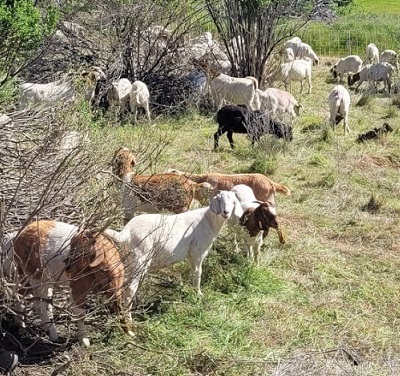Lake Oroville Community Update - April 9, 2021
Goats reduce vegetation near diversion pool in Oroville. DWR/2021 
DWR Begins Monitoring Vernal Pools
Some grasslands, including areas around Butte County, have an underlying impervious layer of rock or clay that causes rainwater to pond in the winter and spring, creating seasonal wetlands called vernal pools. Although vernal pools are only a small component of our local grasslands in terms of area, they support a remarkably high diversity of plants and animals, including rare and endangered species and species endemic to California (i.e., found nowhere else in the world).
Vernal pool organisms and plants are highly specialized to their unique environment and to the Mediterranean-type climate found in California. They have adapted to living in pools that fill in the winter but are completely dry by the summer, as well as adapting to the sometimes-extreme variability in temperature and rainfall between years. Vernal pools are important targets for conservation because most vernal pools in California have been lost to development, agriculture, and habitat degradation from invasive plants.
Vernal pools often support spectacular wildflowers that bloom from March to May. Each spring, Department of Water Resources (DWR) Environmental Scientists from the Oroville Field Division monitor hundreds of vernal pools around the Oroville area and make assessments on how protection measures for these valuable environmental resources are succeeding.
Additional Campgrounds Open at Lake Oroville
The California Department of Parks and Recreation (CA Parks) has opened up reservations for the Bloomer Point, Bloomer Knoll, and Bloomer Cove boat-in campgrounds, the Foreman Creek boat-in campground, and the floating campgrounds located around Lake Oroville. Group camping at Loafer Creek Recreation Area opens on April 15. Lime Saddle group camping remains closed.
Reservations for camping can be made online by selecting the ‘Reservations’ tab on the Lake Oroville State Recreation Area (LOSRA) webpage. The reservations system needs 48 hours’ notice to process reservations. “Day-of” access to campgrounds is possible if campsites are available.
Oroville Recreation
The Lime Saddle, Bidwell Canyon, and Spillway boat ramps are open for use. Bidwell Canyon and Lime Saddle boat ramps are open 24-hours per day and the Spillway boat ramp is open from 6 a.m. to 8 p.m. daily. The Loafer Creek Boat Ramp remains out of the water. Construction of the brand-new Loafer Point Boat Ramp is nearing completion and will be open later this spring.
The Roy Rogers Trail in the Loafer Creek Recreation Area, previously closed weekdays for hazardous tree removal, is now open. All day use facilities at Lake Oroville State Recreation Area are open. The Lake Oroville Visitor Center remains closed due to COVID-19 restrictions.
DWR and CA Parks invite outdoor enthusiasts to visit the area’s 91 miles of trails, including the 41-mile long Brad Freeman Trail. Mountain bikers, hikers, equestrians, and bicyclists can find trail information on DWR’s interactive map on the Lake Oroville Recreation webpage.
Visit the California Parks LOSRA webpage for current information on facility status as well as current requirements to protect public health during the COVID-19 pandemic. For information about the Oroville Wildlife Area, including the Thermalito Afterbay, visit the California Department of Fish and Wildlife webpage.
Goats Reduce Vegetation Near Diversion Pool
A herd of 350 to 400 goats from Hanski Family Farms LLC were successful in reducing hazardous fuels in nearly five acres in the Lakeland Boulevard area this past week. DWR partnered with the Butte County Fire Safe Council (BCFSC) on this grazing project to reduce the fire risk from grasses, leaves, invasive and non-invasive plants, and other vegetation.
This work is part of DWR’s Fuel Load Management Program, which was started in 2012 to reduce hazardous fuels within the Federal Energy Regulatory Commission (FERC) project boundary. DWR, along with partners CAL FIRE, the California Conservation Corps, BCFSC, Butte County Sheriff’s Office, and California Department of State Parks and Recreation (CA Parks), are all working together to accomplish the same common goal -- reduce wildfire risk, increase public safety, and enhance forest health in areas around Lake Oroville. To date, approximately 675 acres have been treated around the Lake Oroville area by DWR and its partners.
Current Lake Operations
The elevation of Oroville’s reservoir is about 725 feet elevation and storage is about 1.46 million acre-feet -- 41 percent full and 54 percent of historical average. Currently, in the Northern Sierra Basin, rainfall is below average, at 50 percent of normal for this time of year and snowpack is also below average at 51 percent of normal. Dry and warm conditions are forecasted this weekend and into the week of April 12.
DWR continues to assess releases on a daily basis and still plans to reduce releases to conserve water. As of April 8, total releases to the Feather River are 1,300 cubic feet per second (cfs) to meet Bay-Delta water quality and outflow requirement - 800 cfs down the low flow channel through the City of Oroville and 500 cfs from the Thermalito Afterbay Outlet (Outlet) for a total of 1,300 cfs for the Feather River’s high flow channel downstream of the Outlet.
The public can track precipitation, snow, reservoir levels, and more at the California Data Exchange Center at www.cdec.water.ca.gov. Lake Oroville is identified as “ORO”.
All data as of midnight 4/8/2021
